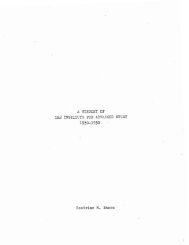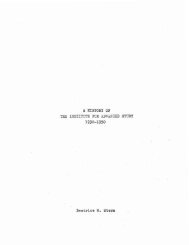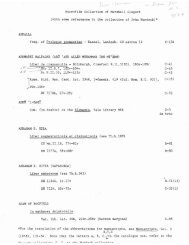First progress report on a multi-channel magnetic drum inner ...
First progress report on a multi-channel magnetic drum inner ...
First progress report on a multi-channel magnetic drum inner ...
You also want an ePaper? Increase the reach of your titles
YUMPU automatically turns print PDFs into web optimized ePapers that Google loves.
air operating against a small turbine to turn the rotor, and a vacuum pump<br />
system as prime mover. With such an arrangement rota.ti<strong>on</strong>al rates of 36,000<br />
X-4<br />
R.P.M. should prove easily feasible, and for a <strong>drum</strong> of about 3" diameter<br />
this would allow roughly the same pulse spacing (.01") as now used. How-<br />
ever, the use of partial vacumn about this rotor introduces a new problem,<br />
since the breakdown voltage between various electrical c<strong>on</strong>ductors is<br />
seriously reduced — so that the vi/riting pulse voltage may again become<br />
the limitati<strong>on</strong>.<br />
To sum up, all of the critical factors appear to approach natural<br />
bounds of practicality in the vicinity of 10 pulses per sec<strong>on</strong>d per <strong>channel</strong>,<br />
and at rotati<strong>on</strong>al speeds between 30,000 and 40,000 R.P.M. The number of<br />
digits around each <strong>magnetic</strong> tract seen: also bounded somewhere between 2000<br />
and 5000. Also with pulses of rou^ly half microsec<strong>on</strong>d durati<strong>on</strong>, the<br />
techniques of "gating" and "counting" are not far from upper limits of<br />
safe performance.<br />
Accordingly, the limits of the r^agnetic <strong>drum</strong> memory technique<br />
may be represented by a single <strong>channel</strong> of capacitj?- 5000 digits, scan rate<br />
10 digits per sec<strong>on</strong>d, and mean access time about 10"^ sec<strong>on</strong>d. The<br />
number of electr<strong>on</strong>ic tubes per <strong>channel</strong> would probably lie between 3 and 6,<br />
If more than <strong>on</strong>e read-write head be used, the rotati<strong>on</strong>al speed or the<br />
access time could be proporti<strong>on</strong>ately reduced.<br />
A typical example of the ultimate design using these techniques<br />
might well be a unit such as the following: a <strong>drum</strong> of seven inch diameter,<br />
duraluminum 24-ST, running 24,000 R.P.M. <strong>on</strong> cascaded c<strong>on</strong>centric bearings,<br />
having four read-write heads per <strong>channel</strong> and 45 <strong>channel</strong>s, in an evacuated<br />
housing and driven by air jet. This might have a total capacity of 2,500<br />
words of 40 binary digits each, with mean access time of 10"^ sec<strong>on</strong>d.
















